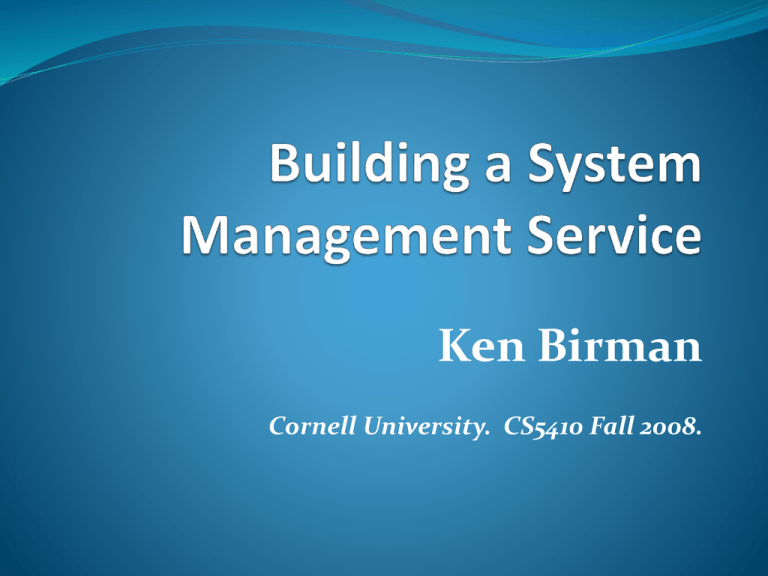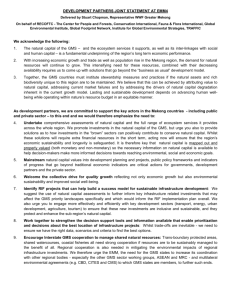pptx
advertisement

Ken Birman
Cornell University. CS5410 Fall 2008.
Last week looked at time
In effect, we asked “can we build a time service for a
data center”?
Reached two conclusions
One focused on event ordering
The other was a true synchronized clock
This week, we’ll use some of the ideas from the time
service to build a powerful system management service
Oracle
Hear and obey.
The primary is
down. I have
spoken!!!
An all-seeing eye.
Track membership
crash
primary
Clients obey it
If the oracle errs
we “do as it says” anyhow
This eliminated our
fear of inconsistency.
backup
Using the Oracle to manage a
system
For many purposes, Oracle can “publish decrees”
“Failure” and “Recovery” don’t need to be the only cases
For example
“Engines at warp-factor two!”
“Reject non-priority requests”
“Map biscuit.cs.cornell.edu to 128.57.43.1241”
Imagine this as an append-only log
P failed
Using the Oracle to manage a system
If we give the records “names” (like file paths) we can
treat the log as a set of logs
/process-status/biscuit.cs.cornell.edu/pid12345
/parameters/peoplesoft/run-slow=true
/locks/printqueue
Thus one log can “look” like many logs
Clients append to logs
And they also “subscribe” to see reports as changes occur
Many roles for Oracles
Track membership of a complex system
Which applications are up? Which are down?
Where are service instances running? (“GMS” function)
Use it as “input” for group applications, TCP failure
sensing, load-balancing, etc.
Lock management
Parameter and status tracking
Assignment of roles, keys
DNS functionality
Scalability
Clearly, not everything can run through one server
It won’t be fast enough
Solutions?
Only use the Oracle “when necessary” (will see more on
this later)
Spread the role over multiple servers
One Oracle “node” could be handled by, say, three servers
And we could also structure the nodes as a hierarchy, with
different parts of our log owned by different nodes
Requires “consensus” on log append operations
Consensus problem
A classic (and well understood) distributed computing
problem, arises in a few variant forms (agreement,
atomic broadcast, leader election, locking)
Core question:
A set of processes have inputs vi {0,1}
Protocol is started (by some sort of trigger)
Objective: all decide v, for some v in the input set
Example solution: “vote” and take the majority value
Consensus with failures
The so-called FLP (Fischer, Lynch and Patterson)
result proves that any consensus protocol capable of
tolerating even a single failure must have nonterminating runs (in which no decision is reached)
Proof is for an asynchronous execution; flavor similar
to that of the pumping lemma in language theory
Caveat: the run in question is of probability zero
Aside: FLP Proof
The actual proof isn’t particularly intuitive
They show that any fault-tolerant consensus protocol
has infinite runs that consist of purely bivalent states
The intuition is that delayed messages can force a
consensus protocol to “reconfigure”
The implicit issue is that consensus requires a unique
leader to reaches the decision on behalf of the system.
FLP forces repeated transient message delays
These isolate the leader, forcing selection of a new
leader, and thus delaying the decision indefinitely
Aside: “Impossibility”
A perhaps-surprising insight is that for theory
community, “impossible” doesn’t mean “can’t be done”
In normal language, an impossible thing can never be
done. It is impossible for a person to fly (except on TV)
In the formal definitions used for FLP, impossible means
can’t always be done. If there is even one run in which
decisions aren’t reached, it is “impossible” to decide.
In fact, as a practical matter, consensus can always be
reached as long as a majority of our system is operational
Consensus is impossible.
But why do we care?
The core issue is that so many problems are equivalent
to consensus
Basically, any consistent behavior
FLP makes it hard to be rigorous about correctness
We can prove partial but not total correctness
For the theory community, this is frustrating – it is
“impossible” to solve consensus or equivalent problems
At best we talk about progress in models with Oracles
Consensus-like behavior
We’ll require that our log behave in a manner
indistinguishable from a non-replicated, non-faulty
single instance running on some accessible server
But we’ll implement the log using a group of
components that run a simple state-machine append
protocol
This abstraction matches the “Paxos” protocol
But the protocol we’ll look at is older and was developed
in the Isis system for “group view management”
Group communication
We want the Oracle itself to be a tree, nodes of which
are groups of servers
In fact we can generalize this concept
The general version is a group of processes
… supported by some form of management service
Turtles all the way down, again?
At the core we’ll have a “root” group
Group Communication illustration
p
q
r
s
t
u
Terminology: group create, view, join with state transfer,
multicast, client-to-group communication
“Dynamic” membership model: processes come & go
Recipe for a group communication
system
Back one pie shell
Build a service that can track group membership and
report “view changes” (our Oracle)
Prepare 2 cups of basic pie filling
Develop a simple fault-tolerant multicast protocol
Add flavoring of your choice
Extend the multicast protocol to provide desired delivery
ordering guarantees
Fill pie shell, chill, and serve
Design an end-user “API” or “toolkit”. Clients will “serve
themselves”, with various goals…
Role of GMS
We’ll add a new system service to our distributed
system, like the Internet DNS but with a new role
Its job is to track membership of groups
To join a group a process will ask the GMS
The GMS will also monitor members and can use this to
drop them from a group
And it will report membership changes
Group picture… with GMS
p
q
t
T to
GMS
GMS:
responds:
What is
current
Group Xmembership
created with
P requests:you
Ifor
wish
group
as the X?
only
to join or create
member
group “X”.
GMS notices that q
r
Q joins, now X = {p,q}. Since phas failed (or q
decides to leave)
is
the
oldest
prior
member,
it
s
GMS to T: X = {p}
r joins…
does a state transfer to q
u
GMS
Group membership service
Runs on some sensible place, like the server
hosting your DNS
Takes as input:
Process “join” events
Process “leave” events
Apparent failures
Output:
Membership views for group(s) to which those processes
belong
Seen by the protocol “library” that the group members
are using for communication support
Issues?
The service itself needs to be fault-tolerant
Otherwise our entire system could be crippled by a
single failure!
So we’ll run two or three copies of it
Hence Group Membership Service (GMS) must run
some form of protocol (GMP)
Group picture… with GMS
p
q
r
s
t
GMS
Group picture… with GMS
p
q
t
GMS
GMS
1
0
GMS2
Let’s start by focusing on how GMS tracks its
own membership. Since it can’t just ask the
The GMS is a group
We’llitbuild
first
and
GMS totoo.
do this
needsitto
have
a special
r
then
will
use it when
building
reliable
protocol
for this
purpose.
But only the GMS
multicast
runs thisprotocols.
special protocol, since other
s to do this job
processes just rely on the GMS
In fact it will end up using those reliable
multicast protocols to replicate membership
information for other groups that rely on it
Group picture… with GMS
p
q
t
GMS
GMS
1
0
GMS2
Let’s start by focusing on how GMS tracks its
own membership. Since it can’t just ask the
The GMS is a group
We’llitbuild
first
and
GMS totoo.
do this
needsitto
have
a special
r
then
will
use it when
building
reliable
protocol
for this
purpose.
But only the GMS
multicast
runs thisprotocols.
special protocol, since other
s to do this job
processes just rely on the GMS
In fact it will end up using those reliable
multicast protocols to replicate membership
information for other groups that rely on it
Approach
We’ll assume that GMS has members {p,q,r} at time t
Designate the “oldest” of these as the protocol “leader”
To initiate a change in GMS membership, leader will run
the GMP
Others can’t run the GMP; they report events to the
leader
GMP example
p
q
r
Example:
Initially, GMS consists of {p,q,r}
Then q is believed to have crashed
Failure detection: may make mistakes
Recall that failures are hard to distinguish from
network delay
So we accept risk of mistake
If p is running a protocol to exclude q because “q has
failed”, all processes that hear from p will cut channels to
q
Avoids “messages from the dead”
q must rejoin to participate in GMS again
Basic GMP
Someone reports that “q has failed”
Leader (process p) runs a 2-phase commit protocol
Announces a “proposed new GMS view”
Excludes q, or might add some members who are joining, or
could do both at once
Waits until a majority of members of current view have
voted “ok”
Then commits the change
GMP example
Proposed V1 = {p,r}
Commit V1
p
q
r
OK
V0 = {p,q,r}
V1 = {p,r}
Proposes new view: {p,r} [-q]
Needs majority consent: p itself, plus one more
(“current” view had 3 members)
Can add members at the same time
Special concerns?
What if someone doesn’t respond?
P can tolerate failures of a minority of members of the
current view
New first-round “overlaps” its commit:
“Commit that q has left. Propose add s and drop r”
P must wait if it can’t contact a majority
Avoids risk of partitioning
What if leader fails?
Here we do a 3-phase protocol
New leader identifies itself based on age ranking (oldest
surviving process)
It runs an inquiry phase
“The adored leader has died. Did he say anything to you before
passing away?”
Note that this causes participants to cut connections to the
adored previous leader
Then run normal 2-phase protocol but “terminate” any
interrupted view changes leader had initiated
GMP example
p
Inquire [-p]
q
Proposed V1 = {r,s}
Commit V1
r
OK: nothing was pending
OK
V0 = {p,q,r}
V1 = {r,s}
New leader first sends an inquiry
Then proposes new view: {r,s} [-p]
Needs majority consent: q itself, plus one more
(“current” view had 3 members)
Again, can add members at the same time
Turning the GMS into the Oracle
Build a tree of GMS servers
Each node will be a small replicated state machine
In addition to the group view, members maintain a set
of replicated logs
Log has a name (like a file pathname)
View change protocol used to extend the log with new
events
Various “libraries” allow us to present the service in the
forms we have in mind: locking, load-balancing, etc
Turning the GMS into the Oracle
Proposed V1 = {p,r}
Commit V1
p
q
r
V0 = {p,q,r}
O
K
V1 = {p,r}
Here, three replicas cooperate to implement the GMS as a fault-tolerant
state machine. Each client platform binds to some representative, then
rebinds to a different replica if that one later crashes….
Turning the GMS into the Oracle
This part of the Oracle
owns all events relating to
INRIA/IRISA
Proposed V1 = {p,r}
Commit V1
p
q
r
V0 = {p,q,r}
O
K
V1 = {p,r}
This part of the Oracle
owns all events relating to
Cornell University
Proposed V1 = {p,r}
Commit V1
p
q
Proposed V1 = {p,r}
V0 = {p,q,r}
Commit V1
p
r
O
K
V1 = {p,r}
q
r
V0 = {p,q,r}
O
K
V1 = {p,r}
Turning the GMS into the Oracle
(1) Send events to
the Oracle.
(2) Appended to log.
(3) Reported
Summary
We’re part way down the road to a universal
management service
We know how to build the core Oracle and replicate it
We can organize the replica groups as a tree, and split
the roles among nodes (each log has an “owner”
The general class of solutions gives us group
communication supported by a management layer
Next lecture: we’ll finish the group communication
subsystem and use it to support service replication


